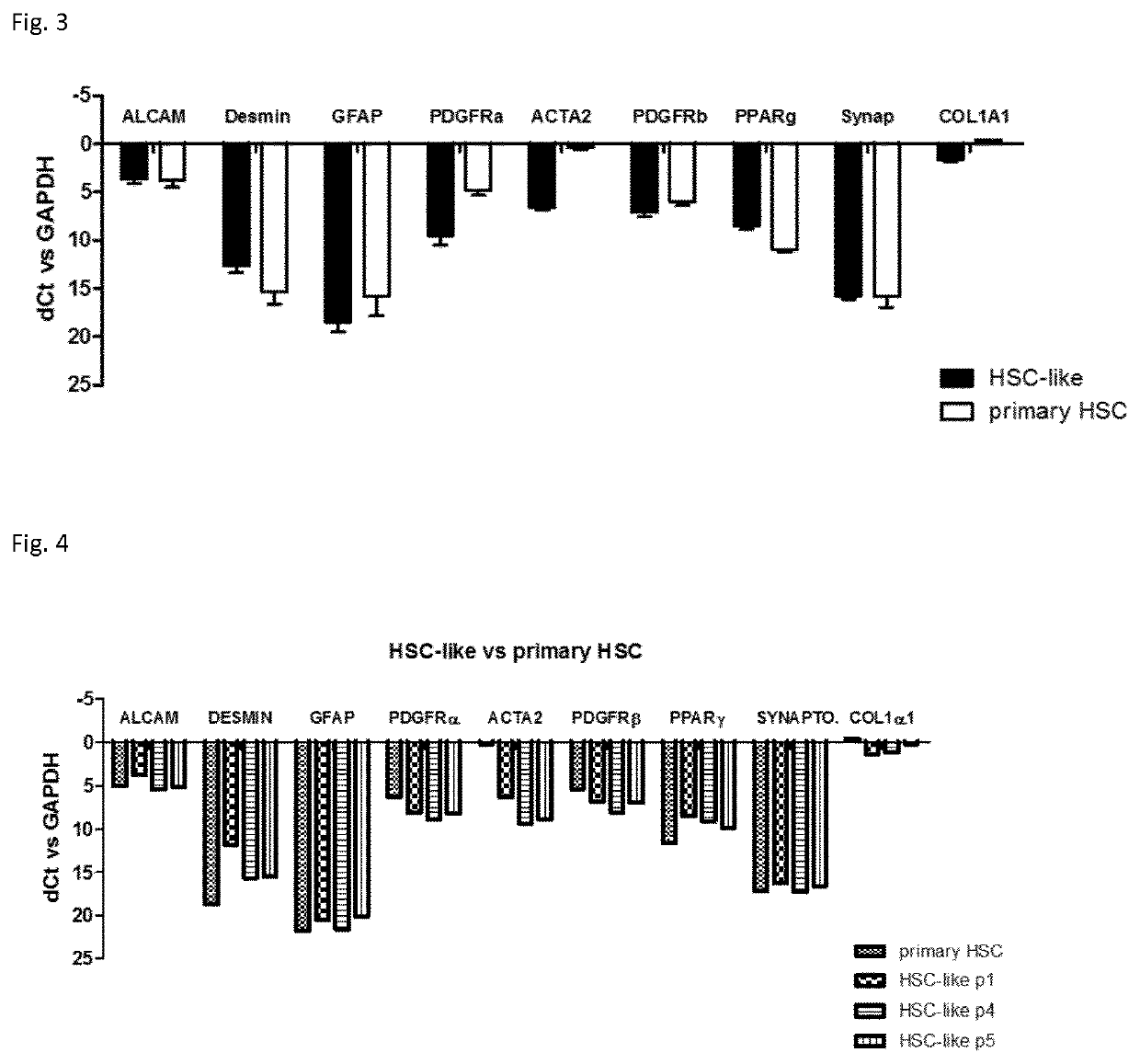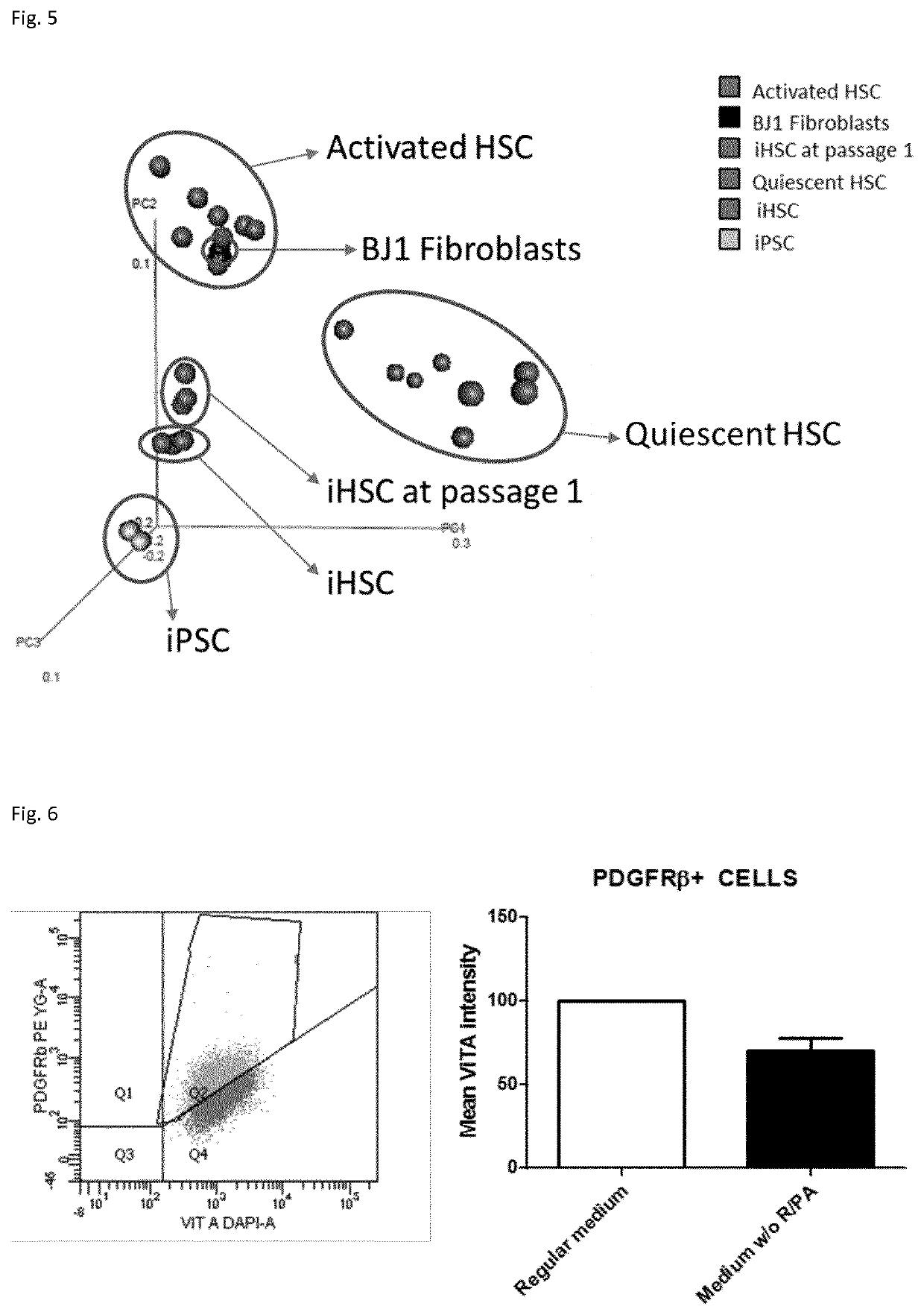Methods for differentiating cells into hepatic stellate cells
a technology of hepatic stellate cells and differentiating cells, which is applied in the field of differentiating cells into hepatic stellate cells, can solve the problems of difficult to obtain, limited proliferative capacity, heterogeneous primary cells,
- Summary
- Abstract
- Description
- Claims
- Application Information
AI Technical Summary
Benefits of technology
Problems solved by technology
Method used
Image
Examples
example 1
Differentiation of Pluripotent Stem Cells to Hepatic Stellate Cell-Like Cells and Characterization
[0141]Pluripotent stem cells (PSC) have an inner cell mass phenotype, and therefore require to be directed along the embryonic and fetal development to acquire a mature hepatic stellate cell (HSC) phenotype. The protocol induces the specification to mesodermal cells, followed by the acquisition of a mesenchymal phenotype, mesothelial and finally the HSC phenotype (FIG. 1). A diagram of the differentiation protocol is found in FIG. 1A. One of the best-described extracellular markers in HSC is PDGFRβ. Therefore, we assessed the number on PSC-derived HSC-like cells by evaluating the percentage of cells expressing this receptor. As shown in FIG. 1B, flow cytometry analysis showed that along differentiation, the percentage of PDGFRβ cells increased, reaching a maximum of about 80% at day 12, suggesting that the majority of the differentiated cells have already acquired HSC phenotype. Moreove...
example 2
Culture of PSC-Derived HSC-Like Cells
[0144]The number of cells from which to start the differentiation is not a concern, since PSC are a renewable source of stem cells and can be expanded almost indefinitely. Therefore, the differentiation could be scaled-up to obtain the desired number of PSC-derived HSC-like cells. However, the differentiation is expensive and for some applications it may be desirable to have the possibility to expand the PSC-derived HSC-like cells. In order to expand and subculture HSC-like cells, we have adapted the culture conditions for primary HSC. PSC-derived HSC-like cells could be expanded for several passages in culture while maintaining the phenotype of differentiated HSC-like cells. Moreover, PSC-derived HSC-like cells showed a phenotype similar to primary HSC, which was preserved upon sub-culture (FIG. 4).
example 3
Transcriptomic Analysis of PSC-Derived HSC-Like Cells
[0145]In order to further characterize PSC-derived HSC-like cells, a transcriptomic analysis was performed with differentiated cells and PSC-derived HSC-like cells at passage 1, and results were compared to parental undifferentiated PSC and primary quiescent and activated HSC. As shown in FIG. 5, principal component analysis, showed a clear clustering of each group of cells. Moreover, PSC-derived HSC-like cells showed an intermediate phenotype between quiescent and activated HSCs. Interestingly, PSC-derived HSC-like cells at passage 1, showed a closer identity to cultured activated HSC, suggesting that this expression profile could be due to culture conditions. Hierarchical cluster analysis of uncultured quiescent HSC and PSC-derived HSC-like cells showed a clear clustering of groups, showing that PSC-derived HSC-like cells still show differences in gene expression to quiescent HSC (data not shown). These differences may be relate...
PUM
| Property | Measurement | Unit |
|---|---|---|
| concentration | aaaaa | aaaaa |
| concentration | aaaaa | aaaaa |
| fluorescence | aaaaa | aaaaa |
Abstract
Description
Claims
Application Information
 Login to View More
Login to View More - R&D
- Intellectual Property
- Life Sciences
- Materials
- Tech Scout
- Unparalleled Data Quality
- Higher Quality Content
- 60% Fewer Hallucinations
Browse by: Latest US Patents, China's latest patents, Technical Efficacy Thesaurus, Application Domain, Technology Topic, Popular Technical Reports.
© 2025 PatSnap. All rights reserved.Legal|Privacy policy|Modern Slavery Act Transparency Statement|Sitemap|About US| Contact US: help@patsnap.com



